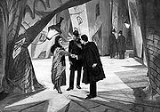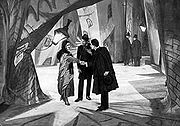
Mise en scène
Encyclopedia

Design
Design as a noun informally refers to a plan or convention for the construction of an object or a system while “to design” refers to making this plan...
aspects of a theatre
Theatre
Theatre is a collaborative form of fine art that uses live performers to present the experience of a real or imagined event before a live audience in a specific place. The performers may communicate this experience to the audience through combinations of gesture, speech, song, music or dance...
or film
Film
A film, also called a movie or motion picture, is a series of still or moving images. It is produced by recording photographic images with cameras, or by creating images using animation techniques or visual effects...
production, which essentially means "visual theme" or "telling a story
Storytelling
Storytelling is the conveying of events in words, images and sounds, often by improvisation or embellishment. Stories or narratives have been shared in every culture as a means of entertainment, education, cultural preservation and in order to instill moral values...
"—both in visually artful ways
Visual arts
The visual arts are art forms that create works which are primarily visual in nature, such as ceramics, drawing, painting, sculpture, printmaking, design, crafts, and often modern visual arts and architecture...
through storyboarding, cinematography
Cinematography
Cinematography is the making of lighting and camera choices when recording photographic images for cinema. It is closely related to the art of still photography...
and stage design, and in poetically artful ways
Narrative
A narrative is a constructive format that describes a sequence of non-fictional or fictional events. The word derives from the Latin verb narrare, "to recount", and is related to the adjective gnarus, "knowing" or "skilled"...
through direction. Mise-en-scène has been called film criticism
Film criticism
Film criticism is the analysis and evaluation of films, individually and collectively. In general, this can be divided into journalistic criticism that appears regularly in newspapers, and other popular, mass-media outlets and academic criticism by film scholars that is informed by film theory and...
's "grand undefined term."
When applied to the cinema, mise-en-scène refers to everything that appears before the camera
Camera
A camera is a device that records and stores images. These images may be still photographs or moving images such as videos or movies. The term camera comes from the camera obscura , an early mechanism for projecting images...
and its arrangement—composition
Composition (visual arts)
In the visual arts – in particular painting, graphic design, photography and sculpture – composition is the placement or arrangement of visual elements or ingredients in a work of art or a photograph, as distinct from the subject of a work...
, sets
Set construction
Set construction is the process by which a set designer works in collaboration with the director of a production to create the set for a theatrical, film or television production...
, props, actor
Actor
An actor is a person who acts in a dramatic production and who works in film, television, theatre, or radio in that capacity...
s, costumes, and lighting. Mise-en-scène also includes the positioning and movement of actors on the set, which is called blocking
Blocking (stage)
Blocking is a theatre term which refers to the precise movement and positioning of actors on a stage in order to facilitate the performance of a play, ballet, film or opera. The term derives from the practice of 19th century theatre directors such as Sir W. S...
. These are all the areas overseen by the director, and thus, in French film
Cinema of France
The Cinema of France comprises the art of film and creative movies made within the nation of France or by French filmmakers abroad.France is the birthplace of cinema and was responsible for many of its early significant contributions. Several important cinematic movements, including the Nouvelle...
credits, the director's title is metteur en scène, "placer on scene."
Interpretation
This narrow definition of mise-en-scène is not shared by all critics. For some, it refers to all elements of visual style—that is, both elements on the set and aspects of the camera. For others, such as U.S. film critic Andrew SarrisAndrew Sarris
Andrew Sarris is an American film critic and a leading proponent of the auteur theory of criticism.-Career:Sarris is generally credited with popularizing the auteur theory in the U.S...
, it takes on mystical meanings related to the emotional tone of a film.
Recently, the term has come to represent a style of conveying the information of a scene primarily through a single shot—often accompanied by camera movement. It is to be contrasted with montage-style filmmaking—multiple angles pieced together through editing
Film editing
Film editing is part of the creative post-production process of filmmaking. It involves the selection and combining of shots into sequences, and ultimately creating a finished motion picture. It is an art of storytelling...
. Overall, mise-en-scène is used when the director wishes to give an impression of the characters or situation without vocally articulating it through the framework of spoken dialogue, and typically does not represent a realistic setting. The common example is that of a cluttered, disorganized apartment being used to reflect the disorganization in a character's life in general, or a sparsely decorated apartment to convey a character with an "empty soul" (e.g., Robert De Niro's house on the beach in Heat), in both cases specifically and intentionally ignoring any practicality in the setting.
In German
Germany
Germany , officially the Federal Republic of Germany , is a federal parliamentary republic in Europe. The country consists of 16 states while the capital and largest city is Berlin. Germany covers an area of 357,021 km2 and has a largely temperate seasonal climate...
filmmaking in the 1910s and 1920s one can observe tone, meaning, and narrative information conveyed through mise-en-scène. Perhaps the most famous example of this is The Cabinet of Dr. Caligari
The Cabinet of Dr. Caligari
The Cabinet of Dr. Caligari is a 1920 silent horror film directed by Robert Wiene from a screenplay by Hans Janowitz and Carl Mayer. It is one of the most influential of German Expressionist films and is often considered one of the greatest horror movies of the silent era. This movie is cited as...
(1919) where a character's internal state of mind is represented through set design and blocking.
The similar-sounding, but unrelated term, "metteurs en scène" (figuratively, "stagers") was used by the auteur theory
Auteur theory
In film criticism, auteur theory holds that a director's film reflects the director's personal creative vision, as if they were the primary "auteur"...
as a disparaging label for director
Film director
A film director is a person who directs the actors and film crew in filmmaking. They control a film's artistic and dramatic nathan roach, while guiding the technical crew and actors.-Responsibilities:...
s who did not put their personal vision into their films.
Because of its relationship to shot blocking, mise-en-scène is also a term sometimes used among professional screenwriters to indicate descriptive (action) paragraphs between the dialog.
Only rarely is mise-en-scène critique used in other art forms, but it has been used effectively to analyse photography
Photography
Photography is the art, science and practice of creating durable images by recording light or other electromagnetic radiation, either electronically by means of an image sensor or chemically by means of a light-sensitive material such as photographic film...
.
Key aspects of mise en scène
Set design : An important element of "putting in the scene" is set design—the setting of a scene and the objects (props) there in. Set design can be used to amplify character emotion or the dominant mood of a film, or to establish aspects of the character.Lighting : The intensity, direction, and quality of lighting have a profound effect on the way an image is perceived. Light (and shade) can emphasise texture, shape, distance, mood, time of day or night, season, glamour; it affects the way colors are rendered, both in terms of hue and depth, and can focus attention on particular elements of the composition.
Space : The representation of space affects the reading of a film. Depth, proximity, size and proportions of the places and objects in a film can be manipulated through camera placement and lenses, lighting, set design, effectively determining mood or relationships between elements in the story world.
Costume : Costume simply refers to the clothes that characters wear. Using certain colors or designs, costumes in narrative cinema are used to signify characters or to make clear distinctions between characters.
Acting : There is enormous historical and cultural variation in performance styles in the cinema. Early melodramatic styles, clearly indebted to the 19th century theater, gave way in Western cinema to a relatively naturalistic style.

